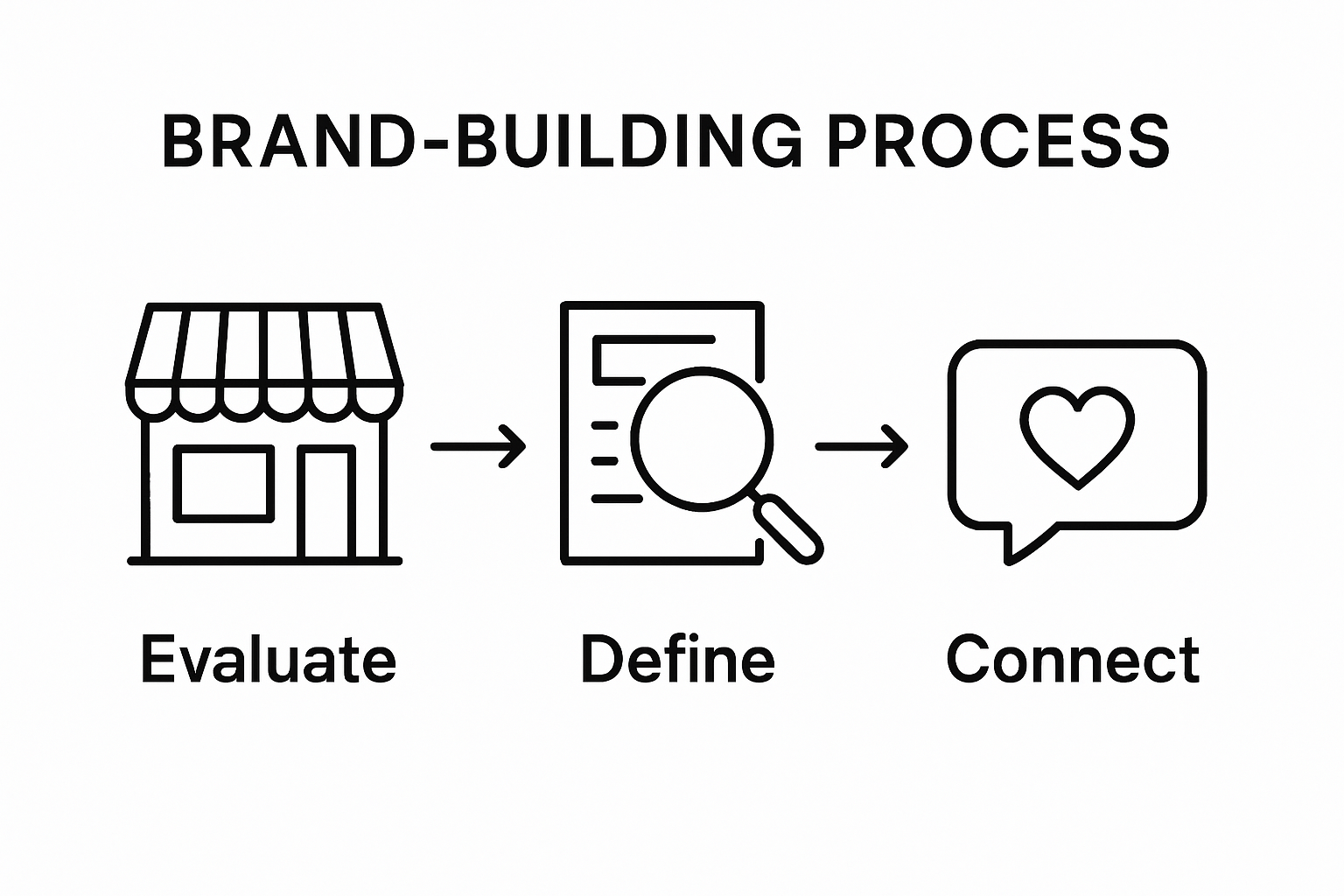Master Branding for Small Businesses: Build Loyalty in 2025
Building a strong brand can feel overwhelming for any small business. But here is the shocker. Transparency and authenticity have become key differentiators against big companies with deep pockets. Most owners think branding is just a logo or a catchy slogan. What actually matters is how real and consistent your business feels at every customer touchpoint. That is what sets you apart and wins real loyalty.
Table of Contents
- Step 1: Evaluate Your Current Brand Identity
- Step 2: Define Your Target Audience And Values
- Step 3: Create Compelling Brand Messaging
- Step 4: Design Consistent Visual Elements
- Step 5: Implement Branding Across All Touchpoints
- Step 6: Measure And Adjust Your Branding Strategy
Quick Summary
| Key Point | Explanation |
|---|---|
| 1. Conduct a brand audit | Evaluate all aspects of your brand identity by assessing your current presentation and gathering feedback from customers and team members. |
| 2. Define customer personas | Create detailed profiles of your target audience that reflect their motivations, challenges, and aspirations beyond basic demographics. |
| 3. Develop brand messaging framework | Craft a storytelling-based communication strategy that includes your mission statement, value proposition, and consistent brand voice. |
| 4. Establish visual branding guidelines | Create a comprehensive style guide detailing your color palettes, typography, and image styles to ensure visual consistency across platforms. |
| 5. Measure brand performance routinely | Implement tracking tools to analyze customer sentiment and engagement, and adjust your branding strategy based on these insights. |
Step 1: Evaluate Your Current Brand Identity
Building a compelling brand for small businesses starts with honest self-assessment. Your brand identity is more than a logo or color palette—it represents the core personality and promise your business communicates to customers. Understanding where you currently stand provides the crucial foundation for strategic branding efforts.
Begin by conducting a comprehensive brand audit that examines every external and internal touchpoint. Review your website, social media profiles, marketing materials, customer interactions, and communication style. Ask yourself critical questions: Does your current presentation accurately reflect your business values? Are your messaging and visual elements consistent? Transparency and authenticity are key differentiators in today’s competitive marketplace.
Your evaluation should include gathering feedback from multiple perspectives. Conduct short surveys with existing customers to understand their perception of your brand. Reach out to team members and ask them how they would describe the company’s essence. Consider consulting our guide on understanding brand voice to gain deeper insights into crafting a cohesive narrative.
Document your findings systematically. Create a brand identity worksheet that captures your current positioning, highlighting strengths and identifying potential gaps. Pay special attention to these critical areas:
- Visual consistency across platforms
- Tone and communication style
- Customer perception and emotional connection
- Alignment between stated values and actual business practices
Successful brand evaluation isn’t about perfection but understanding your starting point. Recognize that your brand identity will evolve, and this initial assessment provides a baseline for strategic improvements.
 By taking a methodical approach, you transform brand development from a vague concept into a structured, actionable process that sets the stage for meaningful customer loyalty and business growth.
By taking a methodical approach, you transform brand development from a vague concept into a structured, actionable process that sets the stage for meaningful customer loyalty and business growth.
Step 2: Define Your Target Audience and Values
Defining your target audience and core values transforms branding from a generic exercise into a strategic, meaningful process. This step is about creating a precise blueprint that connects your business deeply with the right customers who will resonate with your mission and offerings.
Start by developing comprehensive customer personas that go beyond basic demographics. These personas should capture not just age and income, but psychological nuances like motivations, challenges, and aspirational goals. Think about the specific problems your product or service solves and the emotional journey your ideal customer experiences. Research their online behaviors, preferred communication channels, and the language they use. Learn more about precise audience segmentation to refine your understanding.
Simultaneously, conduct an introspective exploration of your business values. These are not generic corporate statements but authentic principles that genuinely drive your organization. What fundamental beliefs distinguish your brand? What promises can you consistently deliver? Consider values that transcend transactional relationships and speak to deeper human connections.
Your values and audience definition should create a clear intersection.
Map out how your core principles directly address the needs and desires of your target customer. This alignment transforms your brand from a mere service provider to a meaningful partner in your customers’ lives.
Verify your work by creating a concise document that outlines:
- Detailed customer persona profiles
- 3-5 core company values
- Specific ways your values solve customer challenges
- Unique value propositions that differentiate you
Successful audience and values definition means you can articulate exactly who you serve and why you exist beyond making a profit. This clarity becomes the strategic foundation for all future branding and marketing efforts, ensuring every communication feels authentic and purposeful.
Step 3: Create Compelling Brand Messaging
Crafting compelling brand messaging transforms your business from a generic service provider into a memorable, emotionally resonant experience. This step is about developing a communication strategy that speaks directly to your target audience’s hearts and minds, creating an instant connection that goes beyond transactional interactions.
Effective brand messaging is an art of strategic storytelling. Begin by developing a core narrative that encapsulates your brand’s unique journey, values, and purpose. Explore the power of storytelling in marketing to understand how narrative can elevate your brand communication. Your messaging should answer fundamental questions: Why does your business exist? What problem do you solve? How are you different from competitors?
Develop a messaging framework that includes a clear, concise mission statement, a compelling value proposition, and a distinctive brand voice. This voice should be consistent across all communication channels—whether it’s a website, social media, email, or customer service interaction. Consider your target audience’s language, preferences, and emotional triggers. A tech startup might use a bold, innovative tone, while a wellness brand might prefer a nurturing, empathetic approach.
Practical implementation requires creating messaging guidelines that every team member can follow. Document your brand voice characteristics, preferred terminology, and communication style. This ensures consistency and authenticity in every customer interaction.
Verify your brand messaging effectiveness by:
- Testing messaging with a small focus group
- Gathering feedback from current customers
- Measuring engagement across different communication platforms
- Tracking emotional response and resonance
Remember that compelling brand messaging is not about perfection but about genuine connection. Your goal is to create a narrative that makes customers feel understood, valued, and excited to be part of your brand’s journey.
 When done right, your messaging becomes a powerful tool that transforms casual customers into passionate brand advocates.
When done right, your messaging becomes a powerful tool that transforms casual customers into passionate brand advocates.
Step 4: Design Consistent Visual Elements
Visual elements are the silent ambassadors of your brand, communicating your essence before a single word is read. Designing consistent visual elements transforms abstract brand values into tangible, recognizable experiences that customers can see, feel, and remember. Consistency is the cornerstone of visual branding that builds trust and professional credibility.
Explore the critical importance of brand consistency to understand how visual cohesion impacts customer perception. Begin by developing a comprehensive brand style guide that serves as a blueprint for all visual communications. This guide should meticulously detail your color palette, typography, logo usage, imagery style, and graphic design principles. Choose colors that emotionally align with your brand personality—whether that means calm blues for a tech company or energetic oranges for a fitness brand.
Create a versatile yet distinctive visual language that works across multiple platforms. Your visual elements should be flexible enough to adapt to different media—from tiny social media icons to large billboard advertisements—while maintaining their core identity. This means designing scalable logo variations, selecting fonts that read clearly at different sizes, and establishing clear rules for image treatment and graphic elements.
Practical implementation requires investing in professional design tools and potentially working with a graphic designer who can translate your brand vision into precise visual guidelines. Consider creating:
- Primary and secondary color palettes
- Typography hierarchy
- Logo usage specifications
- Image and photography style guidelines
- Graphic element templates
Verify your visual branding effectiveness by conducting an audit across all customer touchpoints. Ensure every visual representation—from business cards to website headers—feels like an integrated part of a cohesive brand story. The ultimate goal is creating visual consistency that makes your brand instantly recognizable, building subconscious trust and emotional connection with your audience.
Step 5: Implement Branding Across All Touchpoints
Implementing your brand across all touchpoints transforms strategic planning into a living, breathing experience that connects with customers at every interaction. Comprehensive brand implementation means creating a seamless narrative that feels intentional and authentic. This step is about ensuring your carefully crafted brand identity resonates consistently across every single customer interaction point.
Learn strategies for growing your brand’s influence and understand how every interaction builds your business’s reputation. Begin by creating a comprehensive brand integration map that identifies every potential customer touchpoint. This includes digital platforms like websites, social media, and email communications, as well as physical interactions such as packaging, business cards, customer service scripts, and physical store experiences.
Each touchpoint should reflect your brand’s visual and verbal identity with precision. Your customer service team should use language that matches your brand voice. Your email templates should incorporate your color palette and typography. Even the tone of automated responses should align with your brand personality. This level of consistency creates a memorable, professional impression that builds trust and recognition.
Develop detailed implementation guidelines that provide clear instructions for every team member. These guidelines should be practical and actionable, offering specific examples of how to represent the brand across different contexts. Consider creating:
- Communication scripts that reflect brand voice
- Visual templates for various platforms
- Training materials for team members
- Workflow processes that embed brand consistency
Verify your brand implementation by conducting regular audits. Mystery shop your own business, review all communication channels, and gather feedback from customers and team members. The goal is to create an experience so cohesive that customers can recognize your brand blindfolded—through tone, style, and emotional resonance.
Below is a checklist table to help you verify if your brand implementation is consistent across all customer touchpoints, ensuring a seamless and professional experience at every interaction.
| Touchpoint | What to Check for Consistency | Verification Method |
|---|---|---|
| Website | Visuals, messaging, and tone | Review site for branding |
| Social Media | Voice, images, and engagement style | Audit company profiles/posts |
| Email Communications | Templates, tone, color palette | Check recent emails sent |
| Packaging & Physical Collateral | Logo usage, color scheme, materials | Inspect samples and materials |
| Customer Service Interactions | Language, friendliness, responsiveness | Mystery shop/customer feedback |
| In-Store/Physical Environment | Decor, signage, employee presentation | Observe on-site experience |
| Automated Responses | Tone and branded messaging | Review auto-replies/messages |
Step 6: Measure and Adjust Your Branding Strategy
Measuring and adjusting your branding strategy transforms your approach from static implementation to a dynamic, responsive system that evolves with your business and audience. Continuous measurement is the heartbeat of effective branding, allowing you to understand what resonates and what needs refinement.
Explore strategies for avoiding common branding pitfalls to understand the nuanced landscape of brand development. Begin by establishing a comprehensive measurement framework that goes beyond surface-level metrics. Track both quantitative and qualitative indicators that reveal how your brand is perceived and experienced. This includes customer sentiment, engagement rates, brand recall, and emotional connection metrics.
Implement robust tracking tools that capture multi-dimensional insights. Use customer surveys, social media sentiment analysis, website analytics, and direct feedback channels to build a holistic view of your brand’s performance. Pay special attention to how different audience segments interact with your brand. Are there variations in perception across age groups, geographic regions, or customer types? These insights provide invaluable guidance for strategic refinement.
The following table summarizes common methods for measuring your branding strategy and suggested tools to help you track each metric for ongoing brand health.
| Measurement Area | Key Metric or Focus | Suggested Tool/Approach |
|---|---|---|
| Customer Sentiment | Brand perception, sentiment | Surveys, sentiment analysis tools |
| Engagement Rates | Social likes, shares, comments | Social analytics platforms |
| Brand Recall | Memorability of brand assets | Focus groups, awareness surveys |
| Emotional Connection | Customer attachment to brand | Qualitative interviews, feedback |
| Website Analytics | Traffic and behavior patterns | Google Analytics, heatmaps |
| Feedback Collection | Input from customers and team | Email surveys, feedback forms |
| Competitive Assessment | Position relative to competitors | Competitor audits, benchmarking |
Create a systematic approach to brand strategy adjustment that includes:
- Quarterly brand perception reviews
- Customer feedback analysis sessions
- Competitive landscape assessments
- Alignment checks between brand promise and customer experience
- Emotional resonance tracking
The goal is not perfection but continuous improvement. Treat your brand as a living entity that adapts and grows. When you identify gaps between your intended brand perception and actual customer experience, develop targeted interventions. This might mean refining messaging, adjusting visual elements, or retraining team members to better embody brand values. Successful brand measurement is about creating a responsive, agile strategy that remains true to your core identity while staying relevant to evolving customer needs.
Turn Your Brand Into a Loyalty Engine With Smart Email Marketing
Are you struggling to turn your new brand identity into real customer connection and revenue? Building consistency across visuals and messaging is only the first step. Without a retention system, even the best brand strategy can fall flat. If you want your audience to remember you, buy from you, and keep coming back, your brand story needs to live inside every inbox.

Now is the time to bridge the gap between your evolving brand and measurable growth. At Take Action, we help small businesses just like yours transform powerful branding into revenue with proven email marketing solutions. Our team uses Klaviyo to build data-driven automations, personalized campaigns, and branded email flows that match your company’s voice and style. Ready to bring your brand vision to life and create loyalty that lasts? Discover how partnering for retention drives your business forward.
Frequently Asked Questions
What is the first step in building a brand for a small business?
The first step in building a brand is to evaluate your current brand identity through a comprehensive brand audit. This involves assessing all your business’s visual and communication elements to understand your strengths and areas for improvement.
How can I define my target audience effectively?
To define your target audience effectively, develop detailed customer personas that capture not just demographics but also motivations, challenges, and emotional journeys of your ideal customers. This understanding will help you create a brand that resonates deeply with them.
What role does brand messaging play in customer loyalty?
Compelling brand messaging is crucial in creating an emotional connection with your customers. It articulates your values, mission, and unique offerings, transforming casual customers into loyal advocates for your brand.
How often should I measure and adjust my branding strategy?
You should measure and adjust your branding strategy on a regular basis, ideally through quarterly reviews. This ongoing process allows you to adapt to customer needs and market changes, ensuring your brand remains relevant and effective.
Recommended
- Understanding the Importance of Brand Consistency | Take Action Blog | Take Action
- 7 Branding Mistakes to Avoid for Your Ecommerce Brand | Take Action Blog | Take Action
- Influencer Marketing Explained: 2025 Guide for Business Growth | Take Action Blog | Take Action
- Growing a Personal Brand: Boost Your Influence by 2025 | Take Action Blog | Take Action
- Understanding the Role of Custom Branding in Business - Blog
- User-Generated Content: Boost Brand Trust and Engagement
